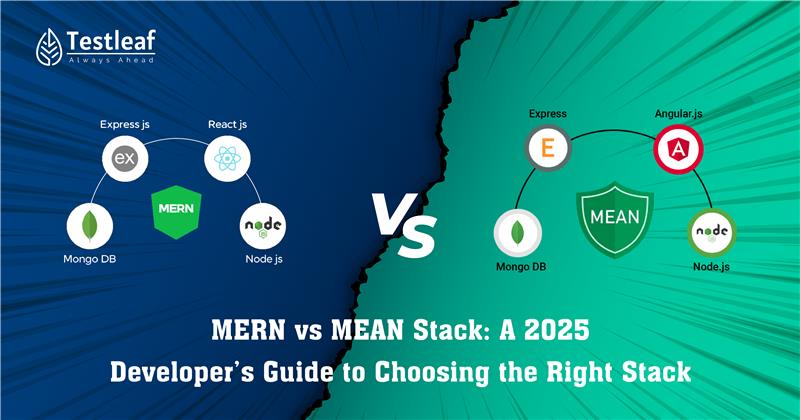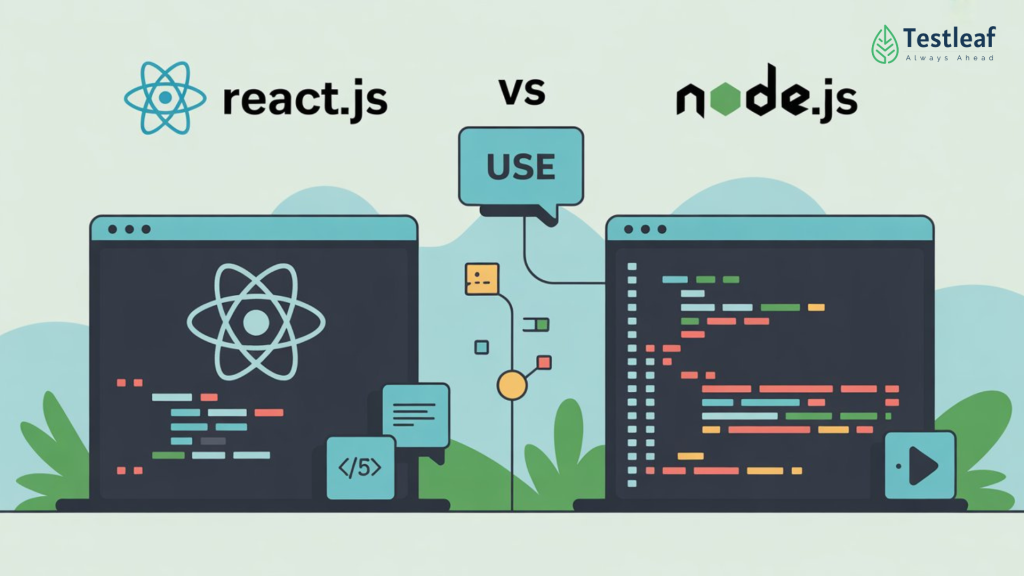Introduction
In the fast-paced world of web development, selecting the right technology stack is crucial for building scalable, high-performance applications. As we move further into 2025, two of the most dominant full-stack JavaScript frameworks remain MERN (MongoDB, Express.js, React, Node.js) and MEAN (MongoDB, Express.js, Angular, Node.js).
Both stacks empower developers to build end-to-end applications using JavaScript, but they cater to different project needs. Whether you’re a beginner exploring a course for full stack developer or an experienced developer deciding between MERN and MEAN, this guide will help you make an informed choice.
Understanding MERN and MEAN Stacks
1. What is the MERN Stack?
The MERN stack is a comprehensive JavaScript framework composed of several key components:
- MongoDB: A NoSQL database that offers scalable data storage and exceptional flexibility.
- Express.js: A lightweight backend framework for Node.js.
- React: A front-end library developed by Facebook for building dynamic UIs.
- Node.js: JavaScript runtime environment based on Node.js.
2. What is the MEAN Stack?
A MEAN stack is another JavaScript solution, including:
- MongoDB: A schema-less NoSQL database ideal for JSON-based storage.
- Express.js: Framework simplifies API development.
- Angular: A front-end framework by Google for building structured SPAs.
- Node.js: Powers the server-side logic.
MongoDB, Express.js, and Node.js are shared between the two stacks. However, their frontend technologies are very different—React and Angular, respectively.
MERN vs MEAN: Key Differences in 2025
1. Frontend Framework: React vs Angular
MERN (React)
- Flexibility: React is a library, allowing developers to pick and choose tools (e.g., Redux, Next.js).
- Virtual DOM: Enhances performance by reducing direct DOM updates.
- Component-Based: Encourages reusable UI components.
- JSX Syntax: Combines HTML and JavaScript for better readability.
- Strong Community: Backed by Meta (Facebook) and widely used in modern web apps.
MEAN (Angular)
- Full Framework: Offers an integrated solution for routing, form handling, and HTTP management.
- Two-Way Data Binding: Simplifies real-time UI updates.
- TypeScript Support: Improves code reliability with static typing.
- Steeper Learning Curve: More complex due to its extensive features.
- Enterprise-Ready: Preferred for large-scale applications.
2. Performance Comparison
- MERN (React + Node.js):
- Faster rendering due to Virtual DOM.
- Ideal for real-time apps (e.g., chat apps, dashboards).
- MEAN (Angular + Node.js):
- Better for data-heavy applications (e.g., enterprise software).
- Slightly slower initial load due to larger bundle size.
3. Learning Curve & Developer Experience
- MERN: Easier for beginners, making it a great choice for those taking a course for full stack developer.
- MEAN: Requires deeper knowledge of TypeScript, modules, and dependency injection.
4. Scalability & Use Cases
- MERN: For startups, minimum viable products (MVPs), and dynamic web applications, the MERN stack is the optimal choice.
- MEAN: Suited for large-scale enterprise apps requiring strict architecture.
5. Job Market & Industry Trends (2025)
- MERN: High demand due to React’s dominance in modern web development.
- MEAN: Still relevant in corporate environments and long-term projects.
Pros and Cons of MERN and MEAN in 2025
MERN Stack Pros:
- Faster development with reusable React components.
- Strong community & extensive third-party libraries.
- Better performance for real-time applications.
- It is easier to integrate with modern techniques (GraphQL, Next.js).
MERN Stack Cons:
- State management requires additional configuration (Redux, Context API).
- Less opinionated, which may lead to inconsistencies in large teams.
MEAN Stack Pros:
- Complete framework with built-in solutions (routing, forms, HTTP).
- Better for large-scale, structured applications.
- TypeScript enhances code maintainability and scalability.
MEAN Stack Cons:
- Steeper learning curve, especially for beginners.
- Slower performance in some cases due to framework size.
When to Choose MERN in 2025?
- Building single-page applications (SPAs) with dynamic content.
- Need for fast rendering (e.g., social media, e-commerce).
- Prefer flexibility in choosing libraries and tools.
- Startups and agile development environments.
When to Choose MEAN in 2025?
- Developing enterprise-grade applications with strict architecture.
- Two-way data binding and TypeScript support are needed.
- A framework with a structured, opinionated approach is required for large teams.
- Long-term projects where scalability is critical.
Future Trends: MERN vs MEAN in 2025 & Beyond
- MERN continues to dominate with React’s growing ecosystem.
- MEAN remains strong in corporate environments but faces competition from newer stacks.
- Hybrid approaches (e.g., Express.js with Next.js or Vue.js) are gaining popularity.
Which Stack Should You Learn in 2025?
If you’re considering a course for full stack developer, here’s what to focus on:
For MERN Stack:
- Learn React hooks, Redux state management, and Next.js.
- Learn MongoDB with Mongoose for database operations.
- Explore Node.js with Express.js for backend APIs.
For MEAN Stack:
- Deep dive into Angular with TypeScript.
- Understand Angular modules, services, and dependency injection.
- Practice Node.js + Express.js for RESTful APIs.
Both stacks are valuable, and learning either (or both) will boost your career in 2025 and beyond.
The top courses for full stack developers in 2025
If you’re looking to master MERN or MEAN, here are some top-rated courses:
MERN Stack Courses:
- “The MERN Stack Front To Back” (Udemy) – This course explores React, Node.js, and MongoDB in detail.
- “Full-Stack Web Development with React” (Coursera) – Offered by Hong Kong University.
- “MERN Stack Bootcamp” (freeCodeCamp) – Free YouTube tutorial series.
MEAN Stack Courses:
- “Angular – The Complete Guide“ (Udemy) – The most comprehensive course for Angular beginners
- “MEAN Stack for Web Developers” (Pluralsight) – Covers Angular and Node.js
- “Full Stack Angular & Node.js” (LinkedIn Learning) – Great for hands-on projects.
Conclusion: Which Stack Should You Choose?
Choosing between MERN vs MEAN depends on:
- Project requirements (speed, scalability, complexity).
- Team expertise (React vs Angular familiarity).
- Long-term maintenance needs.
For fast, modern, and flexible apps, MERN is ideal.
For structured, enterprise-level solutions, MEAN is better.
Understanding both stacks is essential, especially if you’re pursuing a course for full stack developer, as it helps you choose the right technology based on real-world project needs.
We Also Provide Training In:
- Advanced Selenium Training
- Playwright Training
- Gen AI Training
- AWS Training
- REST API Training
- Full Stack Training
- Appium Training
- DevOps Training
- JMeter Performance Training
Author’s Bio:

As CEO of TestLeaf, I’m dedicated to transforming software testing by empowering individuals with real-world skills and advanced technology. With 24+ years in software engineering, I lead our mission to shape local talent into global software professionals. Join us in redefining the future of test engineering and making a lasting impact in the tech world.
Babu Manickam
CEO – Testleaf






